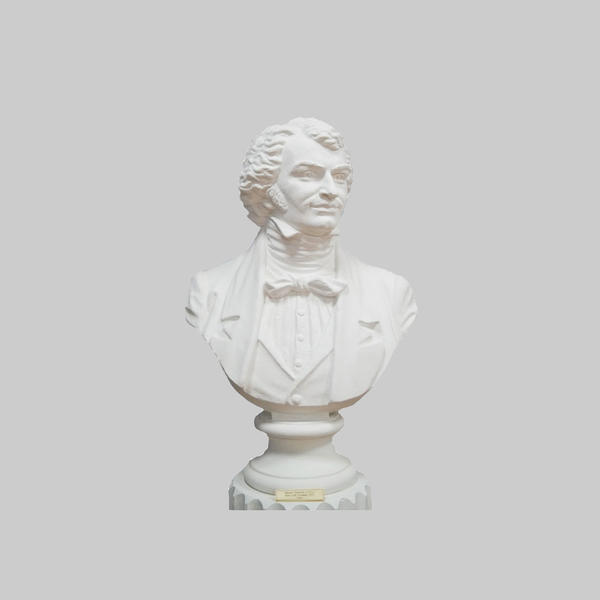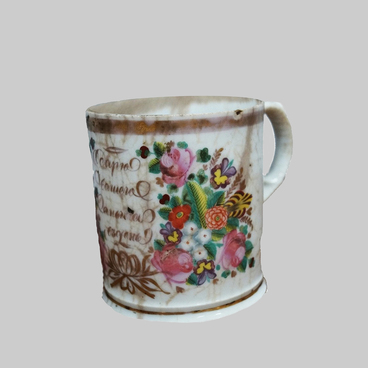The Bust of Stupin, A.V. was made by Mikhail Limonov, a 20th century Arzamas sculptor. He is an author of many other sculptures in Arzamas: monuments to Maxim Gorky, Karl Marx, and Arkady Gaidar; a monument of Komsomol glory; a bust of Georgy Zhukov; and many other works.
Mikhail Limonov was born in 1939 in Buldakovo village in the Arzamas region of the Gorkovsky District. He was drawing and working with clay a lot in his childhood. Limonov searched for flexible materials and then fired the ready pieces in campfire. After the seventh grade, he ventured into Arzamas, where he attended art school.
Mikhail Limonov did not become a sculptor from the beginning. After leaving the army, he moved to Angarsk. He worked as an artist and studied in Penza Art School at the same time. During his work placement, Limonov chose Arzamas. There, he started working as a stonemason engraver in a complex of communal enterprises. In this time the beginner sculptor created many portraits and monuments, among which are busts of Arkady Gaidar, Vladimir Vysotsky, Alexander Pushkin; a monument to Kulikov for Vyyezdnovskaya School; a monument to Alena Arzamasskaia, a Cossack who led a group of serfs and escaped people of Arzamas Province during the Peasant Wars of 1670—1671 (led by Stepan Razin). Since 1980, Mikhail Limonov worked as a teacher of modeling in children’s art school.
In 2001, Mikhail Limonov was awarded the title of Honored Cultural Worker of Russian Federation. Since 2003, he has created sculptures for Moscow: a bas-relief of a young Alexander Pushkin, the compositional portrait of Nikolai Gastello, and later, a live size sculpture of a horse for Poklonnaya Hill. He worked on a monument to participants of local conflicts in Sarov, Nizhny Novgorod Oblast, from 2006 to 2008.
Alexander Stupin was the founder of the first provincial art school in Russia. Limonov made the sculpture in 1997 from gypsum, coating it with a water emulsion paint of white color.
Mikhail Limonov was born in 1939 in Buldakovo village in the Arzamas region of the Gorkovsky District. He was drawing and working with clay a lot in his childhood. Limonov searched for flexible materials and then fired the ready pieces in campfire. After the seventh grade, he ventured into Arzamas, where he attended art school.
Mikhail Limonov did not become a sculptor from the beginning. After leaving the army, he moved to Angarsk. He worked as an artist and studied in Penza Art School at the same time. During his work placement, Limonov chose Arzamas. There, he started working as a stonemason engraver in a complex of communal enterprises. In this time the beginner sculptor created many portraits and monuments, among which are busts of Arkady Gaidar, Vladimir Vysotsky, Alexander Pushkin; a monument to Kulikov for Vyyezdnovskaya School; a monument to Alena Arzamasskaia, a Cossack who led a group of serfs and escaped people of Arzamas Province during the Peasant Wars of 1670—1671 (led by Stepan Razin). Since 1980, Mikhail Limonov worked as a teacher of modeling in children’s art school.
In 2001, Mikhail Limonov was awarded the title of Honored Cultural Worker of Russian Federation. Since 2003, he has created sculptures for Moscow: a bas-relief of a young Alexander Pushkin, the compositional portrait of Nikolai Gastello, and later, a live size sculpture of a horse for Poklonnaya Hill. He worked on a monument to participants of local conflicts in Sarov, Nizhny Novgorod Oblast, from 2006 to 2008.
Alexander Stupin was the founder of the first provincial art school in Russia. Limonov made the sculpture in 1997 from gypsum, coating it with a water emulsion paint of white color.



